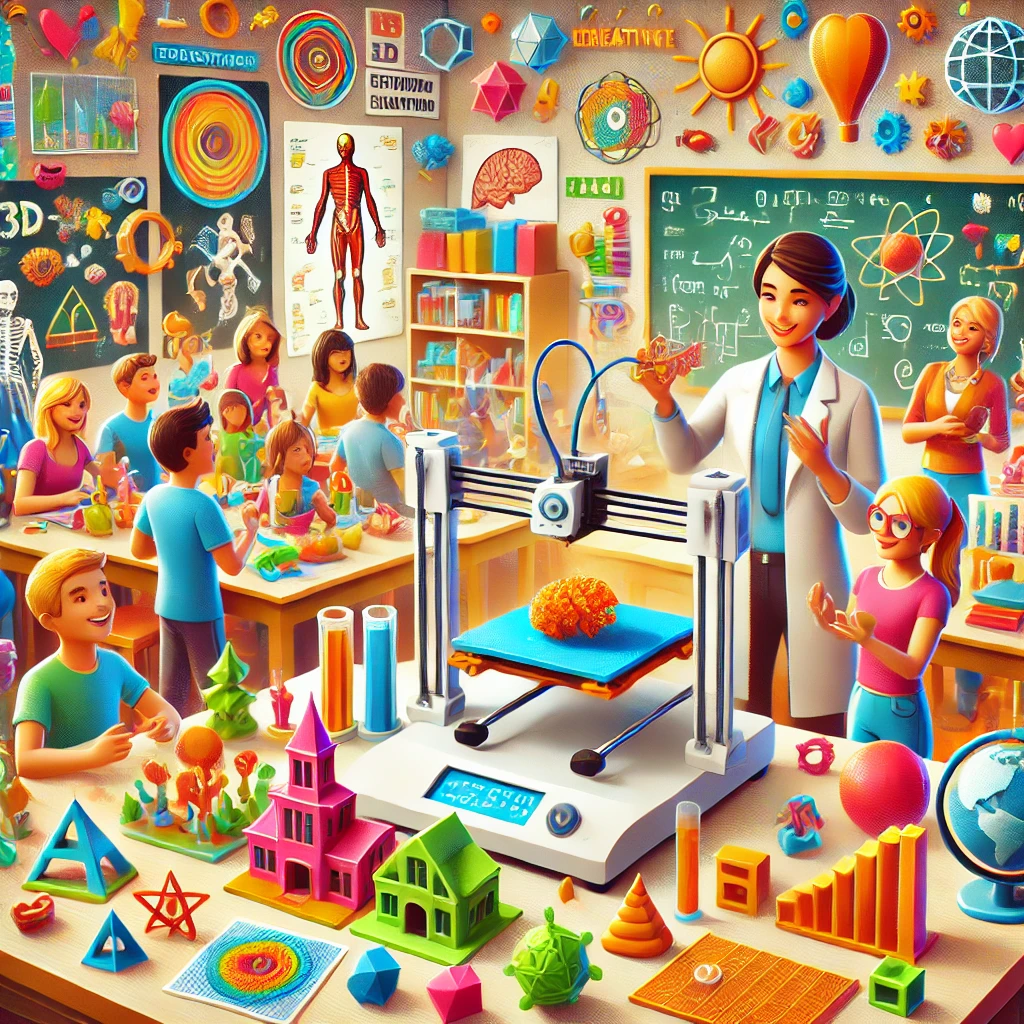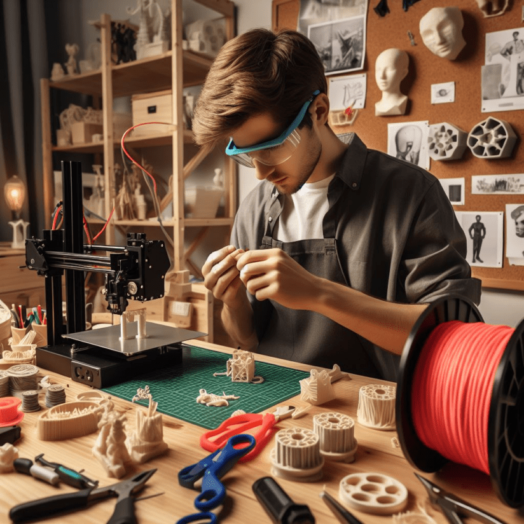
3D printing, also known as additive manufacturing, has emerged as a groundbreaking technology with the potential to revolutionize various industries. From rapid prototyping to customized production, 3D printing offers unparalleled design freedom and manufacturing efficiency. This article delves into two key advancements that are propelling 3D printing to new heights: multi-material mastery and the rise of eco-friendly filaments.
Multi-Material 3D Printing: A Paradigm Shift in Additive Manufacturing
Multi-material 3D printing involves the use of two or more materials within a single print, enabling the creation of objects with varying properties and functionalities. This advancement has opened up a world of possibilities, allowing for the production of complex geometries, intricate designs, and functional components that were previously unattainable with traditional manufacturing methods. Imagine a world where a single 3D printer can produce objects with both rigid and flexible parts seamlessly integrated within the same structure. This is the power of multi-material 3D printing, a technology that is transforming industries and pushing the boundaries of what’s possible with additive manufacturing.
Techniques for Multi-Material 3D Printing
Several techniques have been developed to achieve multi-material 3D printing, each with its own advantages and limitations. Some of the prominent methods include:
- Material Jetting (MJ): This technique involves selectively depositing droplets of different materials onto a build platform, layer by layer. MJ offers high resolution and the ability to print with a wide range of materials, including polymers, ceramics, and metals.
- Direct Ink Writing (DIW): DIW extrudes a continuous stream of material through a nozzle, building up the object layer by layer. This method is particularly well-suited for printing with viscous materials, such as silicone rubbers, and is often used in bioprinting and soft robotics applications.
- Fused Filament Fabrication (FFF): FFF, also known as FDM (Fused Deposition Modeling), is one of the most widely used 3D printing techniques. It involves extruding a thermoplastic filament through a heated nozzle, melting, and depositing the material layer by layer. Multi-material FFF typically utilizes multiple extruders to deposit different materials within the same print.
- Stereolithography (SLA) and Digital Light Processing (DLP): These vat polymerization techniques use a UV light source to cure liquid resin layer by layer. Multi-material SLA and DLP often involve complex systems with multiple vats or intricate resin-switching mechanisms. However, advancements like centrifugal multi-material 3D printing have enabled DLP-based multi-material printing without these limitations. For example, researchers have developed a DLP-based centrifugal multi-material (CM) 3D printing method that can generate large-volume heterogeneous 3D objects with programmable composition, property, and function at the voxel scale.
To better understand the strengths and weaknesses of each technique, consider the following table:
| Technique | Resolution | Material Compatibility | Speed | Cost |
|---|---|---|---|---|
| Material Jetting (MJ) | High | Wide range, including polymers, ceramics, and metals | Moderate | High |
| Direct Ink Writing (DIW) | Moderate | Well-suited for viscous materials | Moderate | Moderate |
| Fused Filament Fabrication (FFF) | Moderate | Wide range of thermoplastics | Moderate | Low |
| Stereolithography (SLA) and Digital Light Processing (DLP) | High | Limited to photopolymers | Moderate to High | Moderate to High |
Applications of Multi-Material 3D Printing
The applications of multi-material 3D printing are vast and span across various industries:
Healthcare
Multi-material 3D printing is revolutionizing healthcare by enabling the creation of patient-specific implants, anatomical models for surgical planning, and customized prosthetics. Imagine a world where medical implants are perfectly tailored to an individual’s anatomy, ensuring optimal fit and functionality. This is now a reality thanks to multi-material 3D printing, which allows for the creation of implants with varying levels of flexibility and rigidity, mimicking the properties of natural tissues.
Beyond implants, multi-material 3D printing is also transforming surgical planning. Surgeons can now use 3D-printed models derived from CT scans to plan intricate surgeries, ensuring greater precision and reducing the risk of complications.
Aerospace
In the aerospace industry, multi-material 3D printing is used to produce lightweight components with complex geometries, combining different materials to achieve optimal strength, durability, and heat resistance. This technology is crucial for creating high-performance aircraft parts that can withstand extreme conditions while minimizing weight.
Furthermore, multi-material 3D printing enables the production of customized tooling and molding options, offering a combination of industry-trusted materials with the benefits of additive manufacturing for complex geometries. This allows aerospace manufacturers to create specialized tools and molds that meet their specific needs, improving efficiency and reducing costs.
Automotive
Automotive manufacturers are leveraging multi-material 3D printing to create customized car parts, interior components with varying textures, and functional prototypes that combine different material properties. This technology allows for the creation of unique designs and functionalities, enhancing the driving experience and improving vehicle performance.
Consumer Goods
Multi-material 3D printing is transforming the consumer goods industry by enabling the production of personalized products, such as footwear with customized insoles, ergonomic tools with varying grip textures, and intricate jewelry designs. This technology allows manufacturers to cater to individual needs and preferences, creating products that are both functional and aesthetically pleasing.
Moreover, multi-material 3D printing is being explored in the optical industry for creating objects with embedded dyes for color blindness correction. This has the potential to improve the lives of millions of people who experience color vision deficiency6.
Challenges and Future Outlook
Challenges
While multi-material 3D printing offers immense potential, it also faces challenges. One of the primary challenges is ensuring material compatibility. Each material used in the printing process must be able to adhere to and bond with the other materials, ensuring a strong and reliable final product. Achieving compatibility between different materials can be a complex task, requiring precise control over factors such as temperature, viscosity, and curing time.
Another challenge is managing the complexity of the printing process itself. Printing with multiple materials often involves more intricate machinery and software, increasing the overall complexity and cost of the system. This can be a significant barrier for smaller businesses or individuals looking to adopt this technology.
Furthermore, the accessibility of AM raises concerns about intellectual property theft and counterfeiting. Protecting digital design files and enforcing intellectual property rights are crucial challenges that need to be addressed.
Future Outlook
Despite these challenges, continuous advancements are being made to address the limitations of multi-material 3D printing. Researchers are constantly developing new materials with enhanced compatibility and experimenting with novel printing techniques to simplify the process. Additionally, advancements in automation and software technology are making the printing process more efficient and cost-effective.
One of the most exciting prospects of multi-material 3D printing is its potential to enable the creation of entirely new materials with unique properties. By combining different materials in precise ways, researchers can achieve properties that are not found in any single material. This has far-reaching implications for various industries, from healthcare to aerospace, where new materials with tailored properties can lead to groundbreaking innovations.
Eco-Friendly Filaments: A Sustainable Approach to 3D Printing
The increasing awareness of environmental issues has led to a growing demand for sustainable practices in 3D printing. Eco-friendly filaments, made from recycled or bio-based materials, offer a greener alternative to traditional petroleum-based plastics.
Types of Eco-Friendly Filaments
Several types of eco-friendly filaments are available, each with its own unique properties and applications:
| Filament Type | Source | Biodegradable? | Properties | Applications |
|---|---|---|---|---|
| PLA (Polylactic Acid) | Corn starch or sugarcane | Yes, under industrial composting conditions | Easy to use, low printing temperature, wide availability | Prototyping, consumer goods, medical devices |
| PETG (Polyethylene Terephthalate Glycol) | Recycled PET | Yes | Good strength, durability, and chemical resistance | Functional parts, prototypes, packaging |
| PHA (Polyhydroxyalkanoates) | Bacterial fermentation | Yes | Good mechanical properties biodegrades in various environments | Packaging, medical devices, consumer goods |
| Recycled Filaments | Post-consumer or post-industrial plastic waste | Varies depending on the source material | Properties vary depending on the source material | Prototyping, functional parts, tooling |
| Bio-Composites | Bio-based polymers with natural fibers (e.g., wood, hemp) | Varies depending on the components | Enhanced strength, stiffness, and sustainability | Consumer goods, furniture, building materials |
| Algae-based filaments | Algae | Yes | Sustainable, reduces algae blooms | Prototyping, consumer goods |
| Coffee-based filaments | Coffee grounds | Yes | Sustainable, utilizes waste from coffee production | Prototyping, consumer goods |
Benefits of Eco-Friendly Filaments
Eco-friendly filaments offer several benefits:
- Reduced Environmental Impact: By using recycled or bio-based materials, eco-friendly filaments minimize reliance on petroleum-based plastics, reduce waste, and contribute to a circular economy. Traditional petroleum-based plastics contribute significantly to plastic pollution and greenhouse gas emissions. These plastics take hundreds of years to decompose, polluting landfills and oceans. Eco-friendly filaments offer a sustainable alternative by reducing our dependence on these harmful materials.
- Improved Sustainability: Eco-friendly filaments support sustainable manufacturing practices by utilizing renewable resources and reducing carbon emissions.
- Enhanced Biodegradability: Biodegradable filaments, such as PLA and PHA, decompose naturally over time, reducing plastic pollution and contributing to a healthier environment.
- Social and Environmental Benefits: In the medical field, 3D-printed prosthetics made from recycled materials have transformed the lives of amputees, offering affordable and environmentally conscious solutions.
- Restoring Damaged Ecosystems: 3D printing has been employed to develop sustainable solutions to preserve ocean ecosystems. Startup Reef Design Lab, for instance, has utilized 3D printing to create artificial coral reefs that mimic natural coral structures, providing a habitat for marine life and helping to restore damaged ecosystems.
Challenges and Future Outlook
Challenges
While eco-friendly filaments offer a promising solution for sustainable 3D printing, they also face challenges. Research has highlighted some challenges associated with eco-friendly filaments, such as ensuring material compatibility, achieving consistent quality, and managing degradation rates11. Some biodegradable materials may not be as durable or heat-resistant as traditional plastics, limiting their applications.
Future Outlook
Despite these challenges, ongoing innovations are addressing the limitations of eco-friendly filaments. Advancements in material science, filament production, and 3D printing technologies are paving the way for wider adoption and increased performance of eco-friendly filaments.

Conclusion,
Multi-material mastery and the rise of eco-friendly filaments are revolutionizing 3D printing, pushing the boundaries of additive manufacturing, and enabling a more sustainable future. These advancements are transforming various industries, from healthcare to aerospace, by offering unparalleled design freedom, enhanced functionality, and reduced environmental impact.
Multi-material 3D printing allows for the creation of objects with intricate designs and complex geometries, combining different materials to achieve optimal performance and functionality. This technology is being used to produce patient-specific implants, lightweight aircraft components, customized car parts, and personalized consumer goods.
Eco-friendly filaments, made from recycled or bio-based materials, offer a greener alternative to traditional petroleum-based plastics. These filaments reduce waste, minimize reliance on fossil fuels, and contribute to a circular economy.
Both multi-material printing and eco-friendly filaments contribute to a circular economy by enabling the reuse and recycling of materials, reducing waste, and minimizing environmental impact. This approach promotes a closed-loop system where materials are continuously reused, minimizing the need for virgin resources and reducing the overall environmental footprint of manufacturing.
As 3D printing technology continues to evolve, we can expect even more groundbreaking innovations that will further revolutionize manufacturing and shape the world around us. The future of 3D printing is bright, with continuous advancements in multi-material printing, eco-friendly filaments, and sustainable practices paving the way for a more efficient and environmentally responsible manufacturing industry.
Buy 3 rolls of filament and get $15 off automatically!
To learn more about these advancements and their potential impact, explore the resources available on websites such as 3D Printing Industry, All3DP, and Raise3D.

